April 18, 2012
by Carole Zangari -
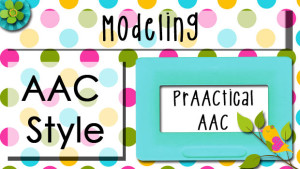
This is a strategy that is too powerful to ignore. Here’s why Aided Language Input is at the top of our list of skills that all clinicians should master. – 1. Helps children and adults learn their AAC faster: There is good research demonstrating how valuable this kind of modeling is for our AAC clients. See studies by Drs. Kathryn Drager, Cathy Binger and Janice Light, Jennifer Kent-Walsh, Shakila Dada and Erna Alant for starters.– 2. Helps the SLP get competent with the client’s AAC system: This is hands-down the quickest way for us to get familiar with our client’s AAC device. – 3. It’s common sense: Think about it: How many times does a typical 1-year old hear the word ‘more’ before she says it?? Don’t AAC kids need that much exposure to ‘their’ language systems?? – 4. Expands our sphere of influence: Other communication partners will imitate us. If WE use it, then parents and teachers are... [Read More...]
Filed under: PrAACtical Thinking
Tagged With: intervention
April 17, 2012
by Carole Zangari -
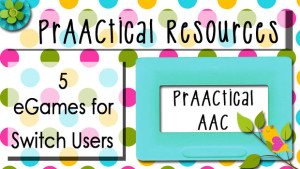
We’re in the mood to play! – 1. AbleGamers Foundation: http://www.ablegamers.com/ 2. Free from Shiny Learning: http://www.shinylearning.co.uk/freegames/ 3. Assistive Gaming: http://www.assistivegaming.com/ 4. Switch Games from the BBC: http://www.bbc.co.uk/cbbc/games/by/type/switchgames 5. Switch Effect’s Gamebase: http://www.gamebase.info/home.html – Let the (accessible) games begin!
Filed under: PrAACtical Thinking
Tagged With: alternate access, play
April 13, 2012
by Carole Zangari -
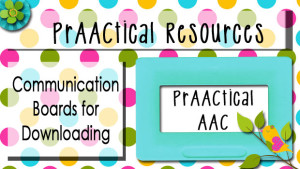
If you’re like us, you’re always happy to find sites where AAC materials can be downloaded, preferably for free. Bookmark those sites because they are huge time savers. If you’re trying to build your own professional resource library, check out this site for boards designed for people to communicate about healthcare, employment, sexuality, transportation, and other topics. Several of the communication boards are also available in Spanish (like the example shown here) and Haitian Creole. Kudos to the fine work done by the AAC-RERC and the Temple University Institute on Disabilities. –
Filed under: PrAACtical Thinking
Tagged With: communication boards, Emergency, Medical, resources
April 12, 2012
by Carole Zangari -
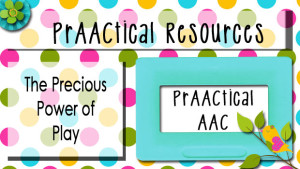
The Chicago P.L.A.Y. Project is on a mission to empower parents to help their children build language through play. We love the joyful nature of their mission. – Of course, the clinical educators in us see huge potential for adding visual supports to enhance the language learning, but this is an amazing way to build good interaction and language opportunities. – Enjoy!
Filed under: PrAACtical Thinking
Tagged With: families, home, play
April 11, 2012
by Carole Zangari -
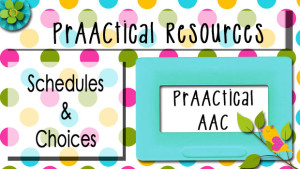
– If you follow our blog, you know that last month we had lots to say on making, teaching, and using Visual Schedules. We ran out of time before we could discuss a question that comes up a lot in our own clinical practice. What role does choice-making play in visual schedules? Here are some of the things we think about when we consider this for the schedules we make and use. We all like to have some say in what we do. Giving the learner an opportunity to make choices in a schedule makes sense when personal autonomy is a priority. Allowing the learner to choose which activities to place on the schedule supports personal autonomy: Having control over what happens in our lives is a big part of happiness for most people. – Here’s how we might do that with a visual schedule for a therapy session. 1.Select... [Read More...]
Filed under: PrAACtical Thinking
Tagged With: visual schedule
April 7, 2012
by Robin Parker -
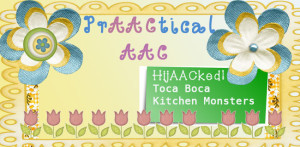
Toca Boca App Developers make general education preschool apps. They are dedicated to providing interactive play opportunities using mobile technology. We have loved every one of their apps since we first saw them. There seems to be some philosophical similarities between the Toca Boca Apps and so we will begin with why we love ALL of them. We have found them to be engaging to all ages (including us). They also provide practice and interaction with life experiences in a fun and pretend tech way. We love the beautiful artwork. We love that they are reasonably priced, often participate in ‘give aways’ and they even do free GIFTS (think Toca Hair Salon Christmas Gift and now Toca Kitchen Monsters). We use these apps so often that we can say we have officially HijAACked them for PrAACtical AAC. We have HijAACked ALL of these apps to use with AAC... [Read More...]
Filed under: PrAACtical Thinking
Tagged With: communication, Opportunities, play, Toca Boca Apps
April 6, 2012
by Carole Zangari -
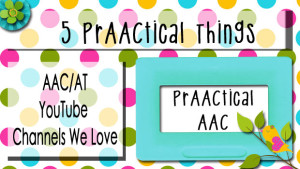
Where do you go for videos on AAC and AT content? Here are some of our favorite YouTube places to visit. 1. Indiana AT Project http://www.youtube.com/indataprojectesc#p/u 2. Pacer Center: http://www.youtube.com/indataprojectesc#p/u 3. AAC-RERC: http://www.youtube.com/user/AACRERC 4. OCALI Videos: http://www.youtube.com/user/ocalivideos 5. Teacher Tube Special Education: http://www.youtube.com/user/teachertubeSPED
Filed under: PrAACtical Thinking
April 5, 2012
by Robin Parker -
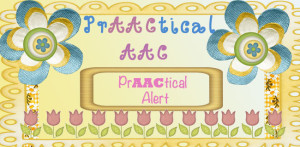
Toca Kitchen Monsters – FREE, A GIFT FROM TOCA BOCA Wow, another amazing & educational app from Toca Boca. Learn to cook and feed the Toca Kitchen Monsters. This app is really fun to play and it’s free (not even any in-app purchase opportunities). The educational part of this app can be focused on cooking and eating language concepts, sequencing of language, and real-life skills (choosing food, cooking, and feeding or eating someone). Although the scope and sequence of this app is ‘real’, there is a main fantasy or pretend play aspect (other than the cooking and eating) – you are feeding funny looking monsters. This is great because all pretending is symbolic and so is language! So get your Toca Kitchen Monsters now! Look out for an updated post tomorrow about how we have HijAACked this app.
Filed under: PrAACtical Thinking
Tagged With: ALert, Apps, communication, Kitchen Monsters, Toca Boca
April 4, 2012
by Carole Zangari -
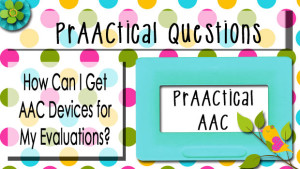
PrAACtical Questions is an occasional series in which we address concerns that our graduate students and others have posed to us about the real world challenges of implementing AAC. This post focuses on AAC evaluations. – The Question: I don’t have many SGDs in my school/clinic. How can I evaluate someone for AAC? — The Situation: A clinician with a good background in using the feature match process for AAC evaluations needs to evaluate a student with severe speech difficulties. Her center has a few AAC devices that she can use for this evaluation but there are a few others that she doesn’t have which are appropriate to consider. There isn’t much chance that she will be given approval to purchase those. How can we get the student an appropriate AAC evaluation? Some Ideas: This is a fairly common problem since few practicing SLPs have access to all of the SGDs, iDevices, apps, and... [Read More...]
Filed under: PrAACtical Thinking
Tagged With: assessment, collaboration, FAQs
April 1, 2012
by Carole Zangari -
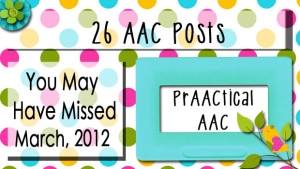
If March was as busy for you as it was for us, then you may have missed some of these posts. Grading exams, meeting with students, clinical paperwork, grant-writing, teaching, travel, etc. Know wonder we’re tired! Enjoy this bit of catch-up. – The Fives 5 Great Resources for Helping Individuals with Vision and Hearing Loss AAC on the Go: 5 Tips for Traveling with AAC Tech it Up’- 5 Visual Schedule Apps 5 Resources for AAC Data Collection 5 Tips to Make AAC Assessments Run Smoothly 5 References to Support AAC Use – PrAACtical Thinking 1. The Secret to Succeeding At Anything 2. National Quilting Day & Employment 3. AAC and March Madness 4. Games are More Than Fun… Gaming for ALL 5. Hearing the Knock 6. HijAACked! AAC & Anti-Bullying with Stand Tall, Mary Lou Melon! 7. Emergencies and Resources to Help 8. Random Acts of Kindness 9. Do... [Read More...]
Filed under: PrAACtical Thinking
Tagged With: visual schedule









